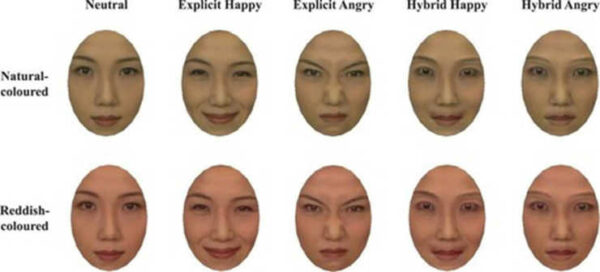It is well known that people associate reddish faces with happiness or anger. But does facial color influence “implicit” facial expression perception, which humans are not explicitly aware of?
A team of researchers from Toyohashi University of Technology’s Visual Perception and Cognition Laboratory and Cognitive Neurotechnology Unit recently investigated the effects of facial color on implicit facial expression perception.
“Some previous research has shown that facial color modulates the recognition of facial expressions, such that the redder the face, the angrier the face appears. Furthermore, intergenerational, and cross-cultural comparisons suggest that the facial color effect may be influenced by language. Therefore, we suggest that facial color also influences implicit facial expressions,”
explained Dr. Tetsuto Minami, who suggested the research idea.
Friendlier Happiness

The research team used special photos with mixed emotions referred to as hybrid emotions, such as a little happiness or a little anger mixed with neutral emotions, in this study.
They discovered that these hybrid emotion photographs were perceived as neutral expressions in the first experiment. In the second experiment, they looked at how pleasant these conflicting feelings appeared in photographs with varied colors, such as reddish and natural tones.
They discovered that reddish colors made happiness appear friendlier, but it had no effect on how we saw angry expressions. They found in the third trial that even with reddish colors, our brains still see these mixed emotions in a hidden way.
Overall, their study shows that the color of a face can quietly affect how we perceive emotions, even when we are unaware of it.
Facial Recognition Applications
The research team thinks that studies in cognitive science or psychology are usually fascinating and very useful. As a result, this research may serve as the foundation for numerous beneficial future applications in a variety of sectors.
“Nowadays, technology has been developing fast with the strength of Artificial Intelligence (AI). However, it is difficult for AI devices to recognize hidden emotions on human faces. Even humans in everyday life have difficulties in recognizing those emotions. Our research hopes to be applicable in areas such as identifying employee attitudes in the company, supporting customer care, identifying criminal psychology,”
said Hoang Nam Nguyen, the first author of the paper. The researchers believe that with the rapid development of modern science and technology, such applications will quickly appear.
But these study findings are merely hinting at preliminary recommendations concerning the theory of the effect of face color on suppressed emotions. The research team thinks that additional testing is still necessary to bolster this claim. Additionally, it’s important to look into other cultural groups with various backgrounds.
Abstract:
Humans recognise reddish-coloured faces as angry. However, does facial colour also affect “implicit” facial expression perception of which humans are not explicitly aware? In this study, we investigated the effects of facial colour on implicit facial expression perception. The experimental stimuli were “hybrid faces”, in which the low-frequency component of the neutral facial expression image was replaced with the low-frequency component of the facial expression image of happiness or anger. In Experiment 1, we confirmed that the hybrid face stimuli were perceived as neutral and, therefore, supported implicit facial expression perception. In Experiment 2, the hybrid face stimuli were adjusted to natural and reddish facial colours, and their friendliness ratings were compared. The results showed that the expression of happiness was rated as more friendly than the expression of anger. In addition, the expression of happiness was rated as friendlier when the low-frequency happy component was red, but the friendliness rating of the expression of anger did not change when it was presented in red. In Experiment 3, we affirmed the implicit facial expression perception even in reddish colours. These results suggest that facial colour modulates the perception of implicit facial expressions in hybrid facial stimuli.
Reference:
- Hoang Nam Nguyen, Hideki Tamura, Tetsuto Minami & Shigeki Nakauchi (2023) The effect of facial colour on implicit facial expressions. Cognition and Emotion, DOI: 10.1080/02699931.2023.2258575
